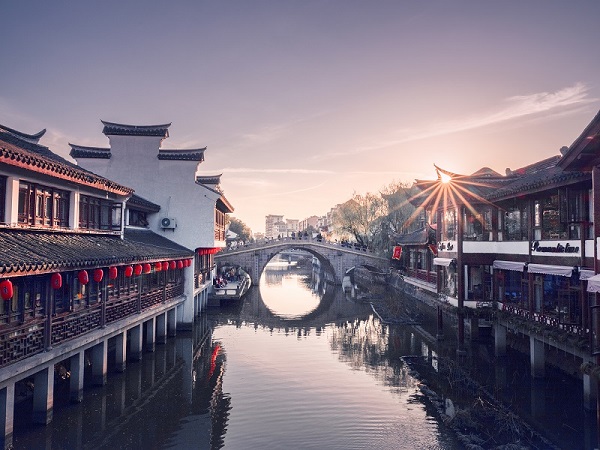Discover Shanghai's hidden gems: Jiangnan-style ancient towns
Shanghai, a bustling metropolis of China, holds hidden treasures — ancient towns steeped in centuries-old history.
These towns embody the unique cultural charm of the Yangtze River Delta, showcasing the essence of Jiangnan heritage, standing as a testament to history and inviting the exploration of their timeless allure.

A Jiangnan-style ancient town in Shanghai. [Photo/VCG]

Zhujiajiao
Zhujiajiao is located in the southwest area of Qingpu district, known as the "Pearl of the south of the lower reaches of the Yangtze River", embedded beside Dianshan Lake.
The core area of the ancient town is 3.08 square kilometers. During the Song (960-1279) and Yuan (1271-1368) dynasties, people started country fairs in the area. Later, a town was officially established during the Wanli period (1573-1620) of the Ming Dynasty. From the late Qing Dynasty (1644-1911) to the Republic of China (1912-49) period, it had become a famous commercial town.
The water network and streets in the town are well preserved, presenting the ancient and simple lifestyle of "small bridges, flowing water and old houses". The remaining ancient buildings and houses include Kezhi Garden, City God Temple, Yuanjin Buddhist Temple, Fangsheng Bridge and the Post Office of the Qing Dynasty.
The antiquity of the bridges, the rareness of the streets and the seclusion of the alleyways all present to you a scene of "boats sailing on the water and people touring in painting".
In 2007, it was selected into the third batch of famous Chinese historical and cultural towns. Today, Zhujiajiao is rejuvenated and has become a unique scenic spot for Shanghai's tourist attractions.

Qibao
Qibao Ancient Town, situated in Minhang district, spans two square kilometers and is easy to navigate by foot.
Crisscrossed by canals, the town boasts traditional houses, restaurants and shops, offering a glimpse into China's history from the 10th century to the 12th century.
Qibao is renowned for its culinary specialties, featuring popular Shanghainese dishes like pig trotters, stinky tofu, steamed stuffed buns, and lamb with rice wine. Nanda Street is a hotspot for local snacks, while Beida Street showcases antique scripts and paintings.
Refurbished buildings house museums, shops, gardens and tea houses, preserving the town's traditional charm.

Fengjing
Fengjing Ancient Town in Jinshan district was inhabited as early as the Neolithic Era. It is surrounded by a network of rivers and waterways and became known as one of the "four famous towns of the Jiangnan region" during the Ming Dynasty (1368-1644) due to its booming textile industry.
As a historical and cultural town, a national top-level tourist attraction and one of the eight new official scenic spots of Shanghai, the town features more than 30 ancient and modern cultural landscapes.
Preserving ancient streets like Heping, Shengchan, Beida, and Youhao, it stands out as the only well-preserved ancient water town in the city.
With great cultural diversity, several notable talents have emerged from Fengjing Town. Cartoons by Ding Cong (1916-2009), paintings by Cheng Shifa (1921-2007), Jinshan Farmers Painting and the Weiqi skills of Gu Shuiru (1892-1971) are called the "three paintings and one game" of the town. The town is also famous for its delicious food, including golden maple rice wine, Fengjing braised pigs' feet, scholar cake and tofu.

Xinchang
About 36 kilometers away from downtown Shanghai in Pudong, Xinchang Ancient Town was established during the Southern Song Dynasty (1127-1279). Xinchang means "new place", arising from the movement of an old salt farm to what is now Xinchang in the early part of the Yuan Dynasty (1271-1368).
Xinchang began to thrive thanks to salt — with the development of the salt industry, salt merchants and vendors flooded to the town, and for a time the town grew even more prosperous than the center of Shanghai. Bridges, streams, folk houses, lanes, teahouses, old shops and ancient temples constitute a picturesque view of the "Jiangnan water town".
More than 55 percent of the architecture from the Ming and Qing dynasties and the Republic of China, have been preserved, making Xinchang the only comparatively complete historical town in Pudong.
Rivers run through the town and there are finely carved stone arch bridges and houses built near streams, as well as a highly built stone revetment, saddle-shaped water bridge and the monumental "stalagmite lane" archway built in 1986.
(Updated on Nov 21, 2025)
Editor's Pick
FAQs
- What if my passport expires but my Chinese visa is still valid?
- Can pets and owners depart from different countries while complying with customs regulations?
- Can a minor travel to China and stay in a hotel without a parent's presence?
- Who is eligible for the 240-hour visa-free transit policy in China?

